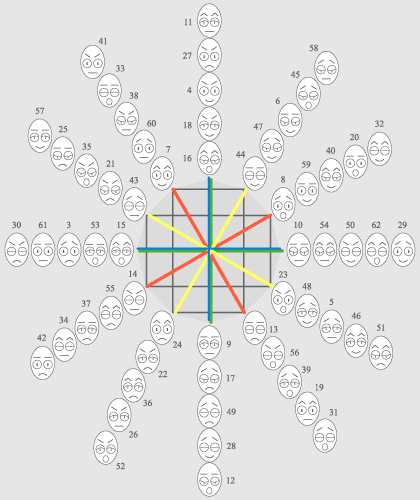-
Five circles of emotions are comparable to division of astrological circle
into 12 parts that allows to consider ratio of hexagrams i-jing and physiognomic
symbols in circles of emotions by analogy to aspects of 12 zodiac signs which
possess harmonious ratio if have aspects 30, 60, 120, 150 degrees, or possess
intense ratio if have aspects 0, 90, 180 degrees according to rules of
astrology. In particular if people born under different signs on the zodiac then
possess mutual relations according to the intense or harmonious aspects of
zodiac signs, and by analogy it is possible to consider mutual relations of
people according to the harmonious and intense aspects of physiognomic symbols
which designate emotional displays in circles of emotions.
For this purpose it is necessary to apply the general scheme which unites five
circles of emotions.
 |
To each of 12 parts of astrological circle there
correspond five physiognomic symbols that corresponds to five circles of
emotions. Physiognomic symbols in the shown scheme do not correspond with concrete signs on the zodiac as the scheme is intended only for consideration of aspects or otherwise to tell angular ratio within five circles of emotions by analogy to aspects of signs on the zodiac. In total 60 physiognomic symbols are presented in five circles, and 4 symbols have no concrete parities with parts of astrological circle as correspond to 1, 2, 63, 64 hexagrams i-jing which symbolize a cross of creation and correspond with four elements. Serial numbers of physiognomic symbols correspond to serial numbers of hexagrams in the Book of Changes i-jing. It is necessary to identify emotions of people and to compare to physiognomic symbols, and after that it is possible to speak about harmonious or inconsistent parities of emotional displays according to aspects of physiognomic symbols. Rules for identification of human emotions by means of physiognomic symbols look in other section of this website. |
-
For example, the face of a person has emotional expression which corresponds
to 11th hexagram i-jing and 11th physiognomic symbol in the fifth circle of
emotions, and the face of a second person has emotional expression which
corresponds to 27th hexagram i-jing and 27th physiognomic symbol in the fourth
circle. It means that in mutual relations of these people there can be
contradictions as the angular ratio or aspect of these physiognomic symbols
within circles of emotions is strained, as aspects 0, 90, 180 degrees are
strained. But if the face of a third person has emotional expression which
corresponds to 38th hexagram and 38 physiognomic symbol in the third circle then
mutual relations with the first or second person can be harmonious as aspects
30, 60, 120, 150 degrees are harmonious.
And also, for example, you assume to communicate with a person who has the
emotional look or expression of a face which corresponds to 11th hexagram i-jing
and 11th physiognomic symbol in the fifth circle, and emotions of your face
correspond to 27th hexagram and 27th physiognomic symbol in the fourth circle,
then dialogue can be strained and consequently it is necessary to alter
emotional displays that dialogue was harmonious. Namely it is necessary to
compare own emotions to any physiognomic symbol which will have harmonious
aspect with 11th physiognomic symbol, and which will have in essence a
harmonious parity with emotions of a prospective subject of dialogue. Thus it is
necessary to consider that modifications of emotions look natural within the
limits of any one circle if such assumption is true, and consequently you can
choose a physiognomic symbol in the fourth circle in the event that emotional
expression of your face corresponds to a physiognomic symbol which is in the
fourth circle of emotions. For example, you can compare own emotions to 46th
physiognomic symbol.
In essence in this example it is necessary to identify own emotions with
emotions of interlocutor and to smile, as 46th and 11th physiognomic symbols are
similar but differ by emotional expressions of mouths, and as a result your
dialogue will be harmonious.
It is a simple example, but not always dialogue of people happens simple, and
not always the smile can solve problems of dialogue, and consequently the shown
scheme of five circles of emotions can be necessary for understanding of
emotional processes which are possible as a result of human mutual relations.
The following page represents the logic device in which the shown circles of emotions can be applied.
-